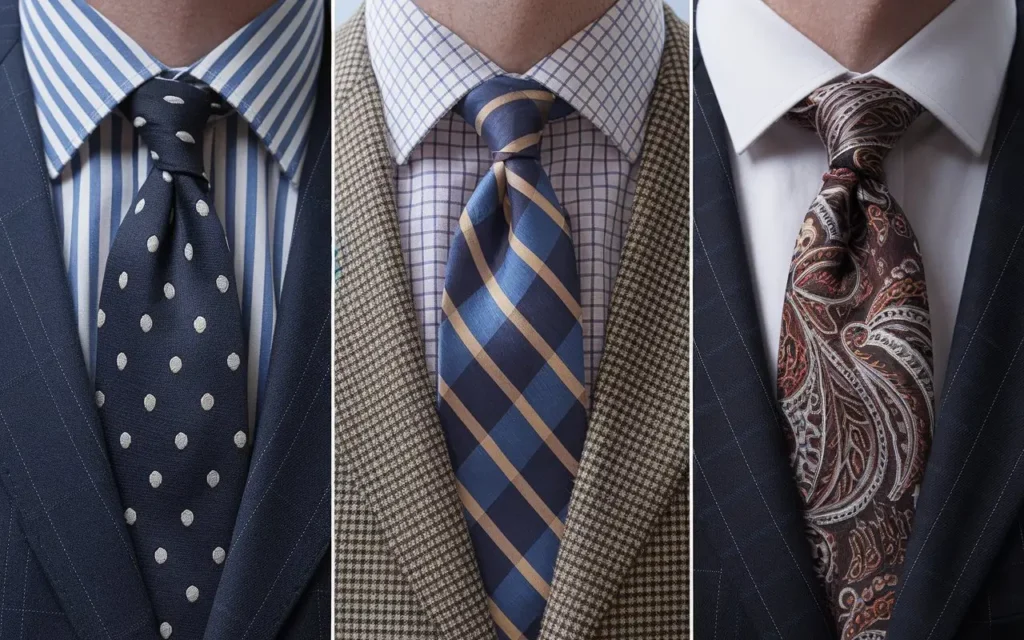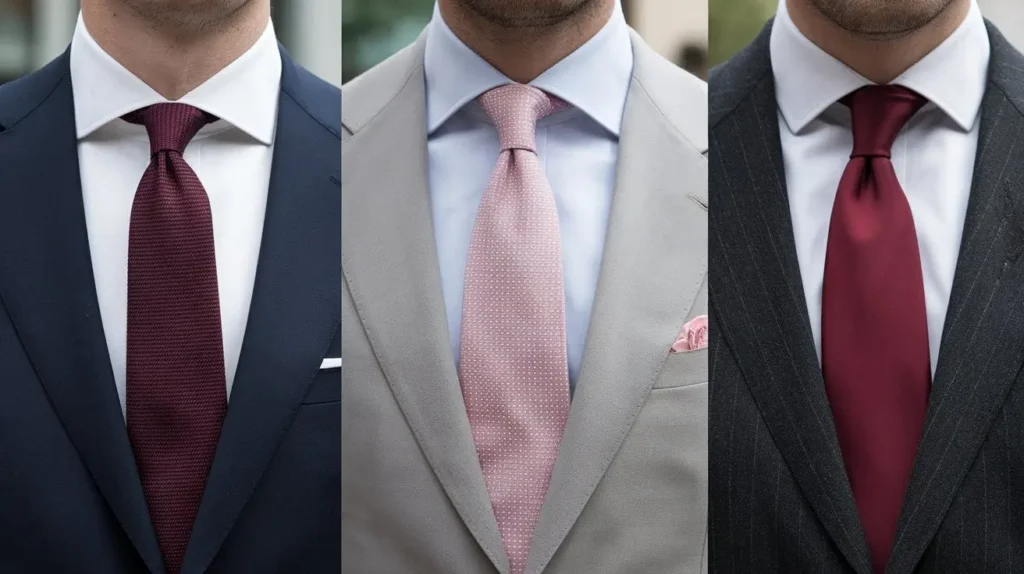Matching Ties With Shirts and Suits: A Comprehensive Guide
Ever stood in front of your closet, tie in hand, wondering if it’ll work with your shirt and suit? You’re not alone. Mastering the art of tie matching can elevate your style game from “meh” to “wow.” But here’s the thing – it doesn’t have to be rocket science.
In this guide, we’ll walk through the essentials of matching ties with different shirt patterns, colors, and suit styles. We’ll cover simple combinations for easy coordination and offer tips on playing with bold patterns and colors without going overboard. Think of it as your go-to handbook for stepping up your suit game—so you can leave those mismatches in the past and walk out the door looking sharp, confident, and ready for anything. Let’s get started!
Contents
The Basics of Tie Matching
Before we get into the nitty-gritty, let’s cover some ground rules. These will serve as your North Star when you’re navigating the sometimes tricky waters of tie matching.
1. Color Coordination 101
Remember the color wheel from the art class? It’s about to become your new best friend. Here’s a quick refresher:
- Complementary colors: These sit opposite each other on the color wheel (like blue and orange). They create a bold, eye-catching look.
- Analogous colors: These are neighbors on the color wheel (think blue and green). They create a harmonious, put-together vibe.
- Monochromatic: This involves different shades of the same color. It’s sleek and sophisticated when done right.
Pro tip: When in doubt, stick to analogous or monochromatic color schemes. They’re harder to mess up and always look polished.
2. Patterns and Scale: The Dynamic Duo
Mixing patterns can be tricky, but here’s a secret: it’s all about scale. The key is to vary the size of your patterns. If your shirt has a small check, go for a tie with a larger pattern. This creates visual interest without clashing.
Remember: One pattern should always be the star of the show. Let it take center stage and keep the others in supporting roles.
Matching Ties With Shirts
Now that we’ve got the basics down, let’s get into the meat of it – pairing ties with shirts.

Solid Shirts: Your Canvas for Creativity
Solid shirts are like a blank canvas – they give you room to play. Here are some foolproof combos:
- White shirt: The world is your oyster. Any color or pattern tie works here. Try a bold red silk tie for a classic power look. (Check out this sleek red tie)
- Light blue shirt: Navy, burgundy, or forest green ties complement beautifully. For a modern twist, consider a knit tie in these colors.
- Pink shirt: Surprisingly versatile. Navy, gray, or even a soft green tie can look sharp. (Here’s a stylish gray tie that pairs wonderfully with pink)
Patterned Shirts: Mixing Like a Pro
Pairing ties with patterned shirts can seem daunting, but it doesn’t have to be. Here’s how to nail it:

- Match the background: If your shirt has a light blue background with a pattern, choose a tie that incorporates that light blue.
- Play with scale: If your shirt has a small pattern, go for a tie with a larger one (or vice versa).
- Use solid ties as a safety net: When in doubt, a solid tie in a color that complements your shirt’s pattern is always a safe bet.
For example, with a blue and white striped shirt, you could rock a solid navy tie or a burgundy tie with small polka dots. (This polka dot tie would work wonders)
White Shirts: The Universal Canvas
Ah, the white shirt – the Switzerland of the shirt world. It goes with everything. Here’s where you can really let your personality shine through your tie choice:
- For a classic look: You can’t go wrong with a repp stripe tie. (This repp stripe tie is a timeless choice)
- To make a statement: Try a bold, patterned tie. Paisley or large florals can look amazing against the crisp white backdrop.
- For a modern edge: Consider a textured tie, like a gray wool or knit tie. (This textured gray tie adds instant sophistication)
Pairing Ties With Suits
Now that we’ve got shirts covered, let’s talk suits. The right tie can make or break your suited look.

Navy Suits: Versatile and Dapper
Navy suits are incredibly versatile. Here’s how to match ties with them:
- Classic pairings: Red, burgundy, or striped ties in these colors always look sharp.
- Modern twist: Try a mustard yellow or forest green tie for a fresh look.
- Pattern play: Polka dots or subtle florals can add personality without going overboard.
Recommendation: This burgundy tie is perfect for navy suits.
Gray Suits: From Light to Charcoal
Gray suits, in all their shades, are a staple in many wardrobes. Here’s how to nail the tie game:
- Light gray: Pastels work wonderfully here. Think soft pink, light blue, or lavender.
- Charcoal: Bright colors pop against this dark backdrop. Try a bold red or deep purple.
- Mid-gray: This is your chance to experiment. Almost any color works, but jewel tones like emerald or sapphire look especially sharp.
For a versatile option that works with any shade of gray, check out this silver tie with a subtle sheen.
Black Suits: Keeping It Classy
Black suits are often reserved for formal occasions, so your tie choice should reflect that:
- Traditional: You can’t go wrong with a crisp white shirt and black tie for black-tie events.
- With a twist: For less formal occasions, try a dark gray or silver tie for a bit of contrast.
- Adding color: If you want to introduce color, stick to deep, rich tones like burgundy or dark green.
This sleek black tie is perfect for formal events with your black suit.
Putting It All Together: Tie, Shirt, and Suit Combinations
Now for the grand finale – bringing all three elements together. Here are some winning combinations:
- Navy suit + light blue shirt + burgundy tie
- Gray suit + white shirt + forest green tie
- Black suit + white shirt + black tie (for formal events)
- Navy suit + pink shirt + navy tie with small patterns
- Light gray suit + white shirt + pastel blue tie
Remember, these are just starting points. As you get more comfortable, feel free to experiment and develop your own signature style.
Balancing Colors and Patterns
When you’re working with all three pieces, here’s a good rule of thumb: two out of the three (suit, shirt, tie) should be relatively simple, letting the third be the star.
For example:
- Patterned tie? Keep the shirt and suit solid.
- Checked shirt? Go for a solid tie and suit.
- Bold colored suit? Stick to more neutral shirts and ties.
Quick Tips for Foolproof Matching
Sometimes, you just need to get dressed and go. Here are some quick tips to keep in your back pocket:
- The “one pattern” rule: When in doubt, stick to one patterned piece (either shirt or tie) and keep the rest solid.
- Use the suit as a neutral base: A navy or gray suit can anchor almost any shirt and tie combination.
Reliable go-to combos:
- Navy suit + white shirt + red tie
- Gray suit + light blue shirt + navy tie
- Black suit + white shirt + black tie
These combinations work every time, no thinking required.
Common Mistakes to Avoid
Even style pros sometimes slip up. Here are some common pitfalls to watch out for:
- Clashing patterns: Remember, vary the scale of your patterns to avoid a dizzying effect.
- Overmatching: Your tie doesn’t need to match your pocket square exactly. In fact, it’s better if it doesn’t.
- Ignoring the occasion: A novelty tie might be fun for a casual Friday, but keep it professional for important meetings or formal events. Learn more about choosing the right tie for different occasions by following the link.
- Neglecting proportion: Make sure your tie width complements your lapel width and shirt collar.
- Forgetting about texture: Don’t overlook the power of mixing textures. A knit tie with a smooth suit can add depth to your look.
Wrapping It Up
And there you have it – your comprehensive guide to matching ties with shirts and suits. Remember, these guidelines are just that – guidelines. As you become more comfortable, don’t be afraid to bend the rules a bit and let your personality shine through.
The most important thing? Wear your choices with confidence. A well-matched outfit paired with self-assurance is unbeatable.
Quick Cheat Sheet
For those mornings when you’re in a rush, here’s a quick reference guide:
- Navy suit: Goes with almost any color tie
- Gray suit: Best with jewel tones or pastels
- Black suit: Stick to dark, rich colors or black
- White shirt: Any tie goes
- Patterned shirt: Solid tie or larger scale pattern
- One pattern rule: When in doubt, only one item (tie or shirt) should have a pattern
Remember, style is personal. Use these tips as a starting point, but don’t be afraid to trust your instincts and develop your own unique look.